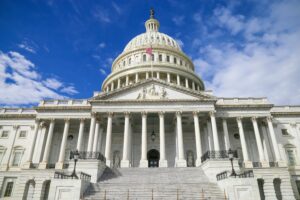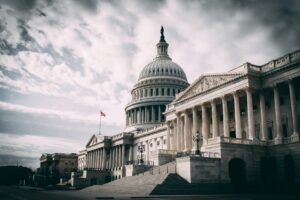Capitol Compass: September 2024 Edition
- On September 25, Congress passed a Continuing Resolution (CR) to extend federal funding until Dec. 20. The bill includes the transfer of $231 million to the Secret Service to improve security for each presidential candidate, a sensitive issue after two alleged assassination attempts against former President Donald Trump.
- The CR does not include several measures such as the Safeguard American Voter Eligibility (SAVE) Act which would require proof of citizenship when registering to vote.
- Speaker Johnson’s initial attempt to enact a six-month CR that included the Save Act was unsuccessful because 14 Republicans sided with Democrats against Johnson. Following internal GOP disagreements, Johnson dropped the voter registration requirement and agreed to the three-month CR period, which Democrats supported.
- The bill increased the divide among the GOP, which previously resulted in Johnson’s predecessor, Kevin McCarthy, being ousted over a similar funding compromise. Notably, every Democrat who voted supported the House bill, indicating that Johnson’s tenure as Speaker will continue to be challenging. Former President Trump threatened to support a government shutdown if Republicans did not include the SAVE Act and made a last-minute push for its inclusion.
- The CR sets up another expenditure conflict before the Dec. 20 due date. Congress intends to pass the 12 annual appropriation bills by then, although Congress is out of session in October and November. Johnson pledged not to approve an omnibus spending package, which often combines all appropriations bills into one, though this is frequently used to meet end-of-year deadlines.
- If appropriations bills are not passed by Dec. 20, Johnson may propose another CR, possibly extending into March, though Democrats may push for additional disaster recovery and veterans affairs funding. November election outcomes will have a direct impact on any legislative activity on the next CR deadline.
Farm Bill
- Despite the passage of the CR, Congress has failed to make any headway on the Farm Bill despite the September 30 deadline. The House and Senate remain split on party lines over funding for the Supplemental Nutrition Assistance Program and conservation initiatives.
- Funding for the federal programs, specifically farm commodity and dairy support programs, will continue until the end of the year. However, “permanent law,” a set of inactive and outdated laws dating to the mid-20th century, would be restored. Permanent law would support dairy, wheat, rice, cotton, and corn but would not support soybeans, peanuts, and sugar, among other commodities. Crop insurance is permanently authorized and will not expire.
- This would result in economic hardship for the agriculture sector and skyrocketing food prices for consumers. Furthermore, SNAP requires an explicit authorization of funding, so Americans on food assistance will face even more hardship.
- The Farm Bill was set to expire at the end of 2023, but Congress passed a 1-year CR that maintained funding at current levels. Congress will likely pass another 1-year CR but may drag into the lame-duck session along with the federal appropriations.
Federal Interest Rates Lowered
- The Federal Reserve cut its benchmark interest rate by 50 points in mid-September to a range of 4.75% to 5%. This is the first interest rate reduction since March 2020, and signals a shift away from the battle against inflation towards promoting job creation and economic growth.
- The Fed is anticipated to keep lowering rates in the following sessions in response to concerns about the labor market and diminishing inflation. If inflation gets closer to the Federal Reserve’s 2% target, these reductions may continue through 2025.
- Treasury Secretary Janet Yellen has not weighed in on the pace of the decline in interest rates, deferring to the Fed which holds sole jurisdiction. However, she recently stated that inflation is under control, and she hopes the job market will stabilize as interest rates fall. The unemployment rate is approximately 4.2% and inflation has decreased to roughly 2.5%.
- In mid-September, applications for unemployment benefits fell to the lowest level since May of this year. This indicates that the job market remains healthy, but there has been a slowdown in hiring.
- The reduction of interest rates aims to encourage increased spending by lowering the interest payments on loans and mortgages for consumers and businesses. This shift signals the start of a new cycle that aims to strike a balance between promoting the overall economy and controlling inflation.
- These economic issues have been the focus of much political discussion during the 2024 campaign season, and we can expect to see continued political messaging through November. However, the impact of these policies will likely not be felt by the public until after the election.


